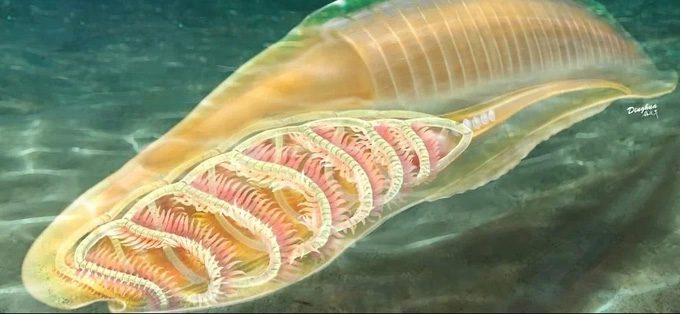A strange organism hidden deep beneath Earth’s oceans over half a billion years ago seems to be the “ancestor” of all vertebrate species we encounter today.

An artistic reconstruction of the biological structure of the yunnanozoan, featuring characteristics linked to modern vertebrates (Image: Science).
This organism is known as yunnanozoan, which lived during the Cambrian period, approximately 518 million years ago. Recent studies have revealed many features in its cartilage layer that closely resemble those of modern vertebrate species.
This suggests that today’s animals may have a close evolutionary relationship with the extinct group mentioned above.
“The fossils of yunnanozoan may be the oldest evidence marking the early evolution of life on Earth, when they exhibited relationships with vertebrates of today,” said researcher Qingyi Tian from Nanjing University and the Chinese Academy of Sciences.
“By employing techniques that have never been introduced before on these specimens, we found evidence that the braincase of the yunnanozoan contains cellular cartilage with a matrix of fine fibers – a characteristic that has until now been considered typical of vertebrates“, Tian shared.
Tracking the evolutionary process of early vertebrates has proven to be a challenging task for scientists. The reason is that after hundreds of millions of years, traces of life have been severely eroded and degraded, leading to fossils that are forgotten or not in good enough condition for analysis.

A fossilized yunnanozoan. (Image: Science).
In some cases, like that of the yunnanozoan, despite having sufficiently good fossils, scientists have puzzled over the decades, unsure of which branch of the tree of life this organism belonged to.
In hopes of clarifying the issue, Tian and colleagues embarked on a study of a total of 127 fossils of yunnanozoan using new methods involving X-ray measurement, electron microscopy, and energy-dispersive X-ray spectroscopy.
As expected, the research team uncovered previously unexplored secrets regarding the anatomy of this strange organism.
The group’s study has been published in the journal Science, and is expected to provide compelling evidence to shed light on some important information regarding the evolutionary process of vertebrates on our planet.




















































